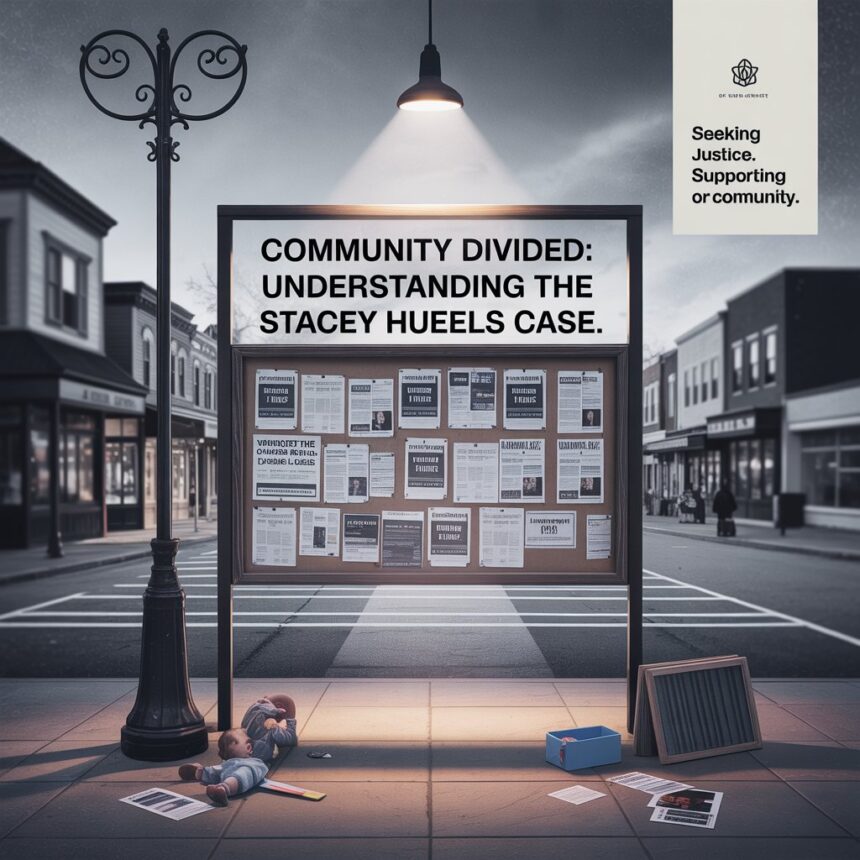Lawsuits involving prominent executives often spark intense public debate. The case referred to as the Stacey Huels lawsuit has captured the attention of community members, banking clients, and industry observers alike. Unlike many sensational courtroom dramas, this lawsuit does not revolve around direct criminal allegations against Stacey Huels herself. Instead, her position as a senior executive in the banking and finance world made her a central figure in testimony and decision-making reviews.
Why is this case important? Because it demonstrates how community trust, financial accountability, and corporate transparency are tested in real time when legal disputes unfold. In this long-form article, we will:
-
Break down the background of the Stacey Huels lawsuit
-
Explore her role as an executive and why her testimony matters
-
Examine the impact on public opinion and community trust
-
Discuss broader implications for governance, compliance, and institutional accountability
-
Answer key FAQs for better clarity
-
Provide a clear conclusion on what lessons can be drawn
Background of the Stacey Huels Lawsuit
Who is Stacey Huels?
Stacey Huels is a senior executive with a long career in corporate leadership. According to official sources such as Wheaton Bank & Trust, she previously served in critical roles in banking and financial management. She later joined Miniat Holdings LLC as a Chief Operating Officer and eventually became its President.
Her professional profile demonstrates deep involvement in decision-making, compliance, and risk management, all of which directly connect to the issues raised in the lawsuit.
What Sparked the Lawsuit?
The dispute reportedly emerged between Wheaton Bank & Trust and Safeco Insurance Company, centering on loan documentation, approval processes, and insurance coverage. While Stacey Huels herself was not sued, her insider knowledge of how financial accounts and loan approvals were handled made her testimony highly significant.
At the heart of the case are questions like:
-
Were the bank’s internal controls strong enough to prevent mismanagement?
-
Were account distinctions (e.g., bonded vs non-bonded) properly understood and managed?
-
Did the institution fulfill its responsibilities in compliance and disclosure?
Her answers during deposition directly influenced how the case was interpreted, shaping both legal strategy and public narrative.
Timeline of Key Developments
-
Pre-Dispute Period: Stacey Huels held senior roles, managing corporate operations and financial oversight.
-
Dispute Emerges: Safeco Insurance raises issues regarding loan documentation and approval.
-
Depositions Begin: Stacey Huels is called to clarify account structures and compliance standards.
-
Public Awareness: Media and blog coverage start highlighting “Stacey Huels lawsuit,” attaching her name to the broader conflict.
-
Ongoing Developments: The community awaits final rulings, while public perception continues to evolve.
Stacey Huels’s Role in the Case
Why Was She Deposed?
As a high-ranking executive, Stacey Huels’s testimony was crucial to establishing:
-
How the bank defined and managed different account types (bonded vs non-bonded)
-
Loan application processes — whether approvals followed due diligence
-
Compliance standards — whether oversight mechanisms met regulatory expectations
-
Accountability structures — who made the final calls in sensitive financial decisions
Even though she was not directly accused, her knowledge provided the court with insights into the institutional mindset and practices.
Key Takeaways From Her Testimony
-
Clarity on Account Types
-
One of the most debated aspects was the distinction between bonded and non-bonded accounts. Huels’s testimony helped clarify how these were defined internally, which influenced the court’s view on liability.
-
-
Documentation and Approval Process
-
She explained how applications were reviewed, what checks were required, and how oversight systems functioned. This testimony aimed to show that the bank had compliance measures in place, even if outcomes were disputed.
-
-
Institutional Responsibility
-
Her role also highlighted how accountability in executive decision-making is distributed. It suggested that institutions cannot hide behind corporate layers when processes are challenged.
-
Impact on Community
Trust in Financial Institutions
The lawsuit highlights how fragile community trust in banks can be. When cases like this arise, customers and community members begin questioning:
-
Are my deposits safe?
-
Are executives acting in my best interest?
-
Can I rely on this institution for transparency?
Even without proven wrongdoing by Huels personally, the public often associates executive names with institutional reputation.
Media Coverage and Public Perception
The term “Stacey Huels lawsuit” has been widely circulated in blog posts, news summaries, and financial commentary. Media framing has a powerful effect:
-
Some coverage portrays her as a competent executive caught in legal scrutiny.
-
Other commentary suggests she represents systemic issues in corporate accountability.
This duality creates a split in public opinion, where supporters emphasize her professionalism while critics highlight perceived institutional failures.
Community Sentiment
Local communities tied to Wheaton Bank & Trust have expressed mixed views.
-
Concerned customers fear that executive testimony implies deeper institutional problems.
-
Supportive voices argue that Huels’s willingness to clarify operations shows integrity and accountability.
-
Neutral observers focus on the lawsuit as a reminder of why compliance and audits matter in finance.
Impact on Public Opinion
Polarized Views
Public opinion tends to polarize in high-profile legal cases:
-
Positive perception: Huels is seen as a professional providing transparency in a tough situation.
-
Negative perception: Her name being linked to a lawsuit is enough for some to doubt the bank’s credibility.
Effect on Reputation
Executives often build their reputation on trust and decision-making integrity. Even when not accused, being named in connection with a lawsuit can cause reputational damage that lasts beyond the courtroom.
Broader Implications
For the Banking Industry
-
Stricter Compliance: Banks may adopt tighter internal control systems to avoid similar disputes.
-
Leadership Accountability: Executives must be ready to testify and justify operations under legal scrutiny.
-
Customer-Centric Transparency: Clearer disclosures may be needed to maintain trust.
For the Community
-
Raised Awareness: People become more aware of their financial institution’s governance.
-
Demand for Transparency: Clients expect clarity in loan documentation and risk management.
-
Informed Decision-Making: Community members may seek banks with stronger reputations for compliance.
For Legal & Regulatory Systems
-
Testing Legal Frameworks: The case challenges whether regulations are sufficient to hold institutions accountable.
-
Potential Reforms: Lawmakers and regulators might propose tighter rules on executive accountability in financial disputes.
Lessons Learned
-
Leadership visibility matters — even if not guilty, executives can become public symbols of institutional issues.
-
Compliance culture is key — banks must have documented, consistent processes to withstand legal review.
-
Transparency builds resilience — open communication with the community reduces long-term reputational harm.
-
Public perception drives outcomes — trust is as valuable as legal victory in financial industries.
FAQs
Q1: Was Stacey Huels the defendant in the lawsuit?
A: No, she was not the defendant. She appeared primarily as a witness due to her executive role.
Q2: What was the lawsuit mainly about?
A: The dispute centered on loan documentation, approval processes, and account distinctions between Wheaton Bank & Trust and Safeco Insurance.
Q3: Why did her testimony matter?
A: As a senior executive, she had insider knowledge of compliance, account structures, and institutional decision-making.
Q4: How has the community reacted?
A: Mixed reactions — some view her testimony as responsible and transparent, while others see it as evidence of institutional weaknesses.
Q5: What does this mean for banking institutions?
A: It shows the importance of strong internal controls, executive accountability, and proactive transparency.
Q6: Could this affect her career long-term?
A: Possibly. Even without wrongdoing, being tied to a lawsuit can affect personal reputation and future opportunities.
Q7: What should customers learn from this case?
A: Always assess your bank’s transparency, audit history, and governance structures before placing trust in its operations.
Conclusion
The Stacey Huels lawsuit is more than just a legal proceeding; it’s a reflection of how executive accountability and institutional transparency influence public trust. While Stacey Huels was not personally sued, her testimony became central to understanding the case, putting her leadership under the spotlight.
For communities, this lawsuit reinforces an important lesson: trust in financial institutions is fragile, and it depends on both legal compliance and public perception. For the banking industry, the case underscores that leaders must not only manage operations but also be prepared to publicly justify them.
Ultimately, the lawsuit’s outcome will affect more than the parties directly involved—it will shape how the community views financial governance, how executives handle accountability, and how much trust people place in institutions managing their money







